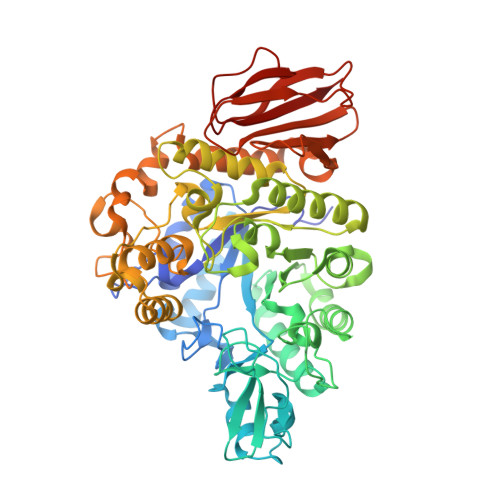Bacillus licheniformis trehalose-6-phosphate hydrolase structures suggest keys to substrate specificity
Lin, M.-G., Chi, M.-C., Naveen, V., Li, Y.-C., Lin, L.-L., Hsiao, C.-D.(2016) Acta Crystallogr D Struct Biol 72: 59-70
- PubMed: 26894535
- DOI: https://doi.org/10.1107/S2059798315020756
- Primary Citation of Related Structures:
5BRP, 5BRQ - PubMed Abstract:
Trehalose-6-phosphate hydrolase (TreA) belongs to glycoside hydrolase family 13 (GH13) and catalyzes the hydrolysis of trehalose 6-phosphate (T6P) to yield glucose and glucose 6-phosphate. The products of this reaction can be further metabolized by the energy-generating glycolytic pathway. Here, crystal structures of Bacillus licheniformis TreA (BlTreA) and its R201Q mutant complexed with p-nitrophenyl-α-D-glucopyranoside (R201Q-pPNG) are presented at 2.0 and 2.05 Å resolution, respectively. The overall structure of BlTreA is similar to those of other GH13 family enzymes. However, detailed structural comparisons revealed that the catalytic site of BlTreA contains a long loop that adopts a different conformation from those of other GH13 family members. Unlike the homologous regions of Bacillus cereus oligo-1,6-glucosidase (BcOgl) and Erwinia rhapontici isomaltulose synthase (NX-5), the surface potential of the BlTreA active site exhibits a largely positive charge contributed by the four basic residues His281, His282, Lys284 and Lys292. Mutation of these residues resulted in significant decreases in the enzymatic activity of BlTreA. Strikingly, the (281)HHLK(284) motif and Lys292 play critical roles in substrate discrimination by BlTreA.
Organizational Affiliation:
Institute of Bioinformatics and Structural Biology, National Tsing Hua University, Hsinchu 300, Taiwan.















